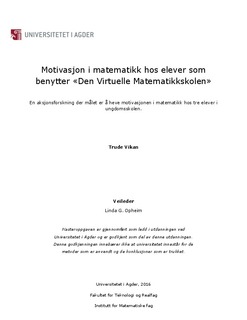| dc.contributor.author | Vikan, Trude | |
| dc.date.accessioned | 2016-10-03T09:30:14Z | |
| dc.date.available | 2016-10-03T09:30:14Z | |
| dc.date.issued | 2016 | |
| dc.identifier.uri | http://hdl.handle.net/11250/2412480 | |
| dc.description | Masteroppgave matematikkdidaktikk – Universitetet i Agder 2016 | nb_NO |
| dc.description.abstract | The title of this study is “Motivation in mathematics among students using Den Virtuelle Matematikkskolen, translated The virtual school of mathematics. The goal of this study was to increase motivation in mathematics among the children I was teaching, and I tried to do it by introducing and working with the web resource “Den Virtuelle Matematikkskolen-U”, shortned DVM-U. I also wanted to find out which impact work with this resource would have for the students motivation in mathematics, and which implications it would have for my work as their teacher. The issue for this study is: In which ways can introduction and work with DVM-U affect childrens motivation in mathematics? I have used the following questions to try and answer the issue: 1. Which changes can I see in the children’s motivation after working with DVM-U? 2. Which changes can I see in the children’s mathematics competence after working with DVM-U? 3. Which challenges and consequences have I met working with DVM-U as a teacher?
This study is a qualitative action research where I have been the teacher for the children and informants. I have been conducting joint group sessions, one-to-one work sessions and interviews to get the clearest impression of the children’s motivation in their work with DVM-U. The data material is collected by sound and video recordings, along with observations and field notes.
The results shows that all the children in the study had changes in their motivation. The changes have been both positive and negative directed. I have measured the motivation by three indicators, joy, joy in achievement, and efforts. These three indicators are also the main codes for my analysis of data material. The children have showed several indicators for strengthened motivation, and few indicators of the opposite. I found the same findings in the interviews conducted with the children. The conclusion is that there has been a positive change in motivation for mathematics among the children in this study. From a pedagogic view an interpretation could be that DVM-U can help the teacher in his work with an instruction customized to every child. DVM-U can supply the mathematics education with a pedagogical software for children with low grade of competence in mathematics. For further research I would suggest a study with DVM-U for a longer period of time to see how the children’s motivation and competence could be affected by the resource. | nb_NO |
| dc.language.iso | nob | nb_NO |
| dc.publisher | Universitetet i Agder ; University of Agder | nb_NO |
| dc.subject | matematikkundervisning | nb_NO |
| dc.subject | Den virtuelle matematikkskolen - Ungdomstrinnet | nb_NO |
| dc.subject | motivasjon | nb_NO |
| dc.subject | DVM-U | |
| dc.subject.classification | MA502 | |
| dc.title | Motivasjon i matematikk hos elever som benytter «Den Virtuelle Matematikkskolen» : en aksjonsforskning der målet er å heve motivasjonen i matematikk hos tre elever i ungdomsskolen. | nb_NO |
| dc.type | Master thesis | nb_NO |
| dc.subject.nsi | VDP::Mathematics and natural science: 400::Mathematics: 410 | nb_NO |
| dc.subject.nsi | VDP::Social science: 200::Education: 280::Subject didactics: 283 | nb_NO |
| dc.source.pagenumber | VII, 77 s. | nb_NO |
